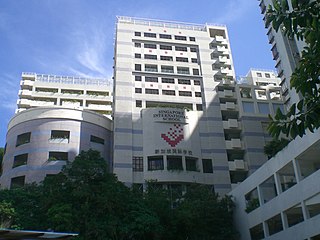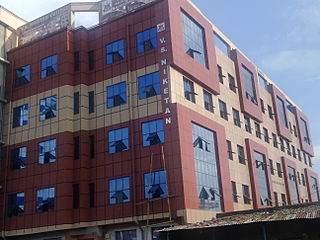
Education is the process of facilitating learning, or the acquisition of knowledge, skills, values, morals, beliefs, habits, and personal development. Educational methods include teaching, training, storytelling, discussion and directed research. Education frequently takes place under the guidance of educators; however, learners can also educate themselves. Education can take place in formal or informal settings, and any experience that has a formative effect on the way one thinks, feels, or acts may be considered educational. The methodology of teaching is called pedagogy.
Education in the United States of America is provided in public, private, and home schools. State governments set overall educational standards, often mandate standardized tests for K–12 public school systems and supervise, usually through a board of regents, state colleges, and universities. The bulk of the $1.3 trillion in funding comes from state and local governments, with federal funding accounting for only about $200 billion. Private schools are free to determine their own curriculum and staffing policies, with voluntary accreditation available through independent regional accreditation authorities, although some state regulation can apply.

Gymnasium is a term in various European languages for a secondary school that prepares students for higher education at a university. It is comparable to the British English terms grammar school and sixth form college and to US English preparatory high school. Before the 20th century, the gymnasium system was a widespread feature of educational systems throughout many European countries.

Physical education, often abbreviated to Phys Ed. or P.E., is a subject taught in schools around the world. It is usually taught during primary and secondary education, and encourages psychomotor learning by using a play and movement exploration setting to promote health and physical fitness. Activities in P.E. include football, netball, hockey, rounders, cricket, four square, racing, and numerous other children's games. Physical education also teaches nutrition, healthy habits, and individuality of needs.
State schools or public schools are generally primary or secondary schools that educate all children without charge. They are funded in whole or in part by taxation. State funded schools exist in virtually every country of the world, though there are significant variations in their structure and educational programmes. State education generally encompasses primary and secondary education.

In education, a curriculum is broadly defined as the totality of student experiences that occur in the educational process. The term often refers specifically to a planned sequence of instruction, or to a view of the student's experiences in terms of the educator's or school's instructional goals. A curriculum may incorporate the planned interaction of pupils with instructional content, materials, resources, and processes for evaluating the attainment of educational objectives. Curricula are split into several categories: the explicit, the implicit, the excluded, and the extracurricular.
A comprehensive school is a public school for elementary aged or secondary aged children that does not select its intake on the basis of academic achievement or aptitude, in contrast to the selective school system where admission is restricted on the basis of selection criteria. The term is commonly used in relation to England and Wales, where comprehensive schools were introduced as state schools on an experimental basis in the 1940s and became more widespread from 1965. With the Blair educational reforms from 2003, they may be part of a local education authority or be a self governing academy or part of a multi-academy trust.
Ninth grade, freshman year, or grade 9 is the ninth year of school education in some school systems. Ninth grade is often the first school year of high school in the United States, or the last year of middle/junior high school. In some countries, Grade 9 is the second year of high school. Students are usually 14–15 years old. In the United States, it is often called the freshman year.

Sha Tin Methodist College (沙田循道衞理中學), abbreviated as STMC, is a government subsidised secondary school founded in 1983; it is sponsored by the Methodist Church, Hong Kong to serve the local community together with churches and service centres in Sha Tin parish.

Education in Bangladesh is overseen by the country's Ministry of Education. The Ministry of Primary and Mass Education is responsible for implementing policy for primary education and state-funded schools at a local level. In Bangladesh, all citizens must undertake ten years of compulsory education which consists of five years at primary school level and five years at high school level. Primary and secondary education is financed by the state and free of charge in public schools.

An international school is a school that promotes international education, in an international environment, either by adopting a curriculum such as that of the International Baccalaureate, Edexcel, Cambridge Assessment International Education or the International Primary Curriculum, or by following a national curriculum different from that of the school's country of residence.

Singapore International School (SIS) is a kindergarten, elementary and secondary school situated in two different campuses on Nam Long Shan Road, Hong Kong Island.

Garden International School (GIS) is a private, co-educational international school in Mont Kiara, Segambut, Kuala Lumpur, Malaysia. Founded in 1951, GIS is one of the oldest and most prestigious private schools in Malaysia. GIS is part of the Taylor's Education Group and a member of the Federation of British International Schools in Asia (FOBISIA).
Education in Tanzania is provided by both the public and private sectors, starting with pre-primary education, followed by primary, secondary ordinary, secondary advanced, and ideally, university level education. Free and accessible education is a human right in Tanzania. The Tanzanian government began to emphasize the importance of education shortly after its independence in 1961. Curriculum is standardized by level, and it is the basis for the national examinations. Achievement levels are important, yet there are various causes of children not receiving the education that they need, including the need to help families with work, poor accessibility, and a variety of learning disabilities. While there is a lack of resources for special needs education, Tanzania has committed to inclusive education and attention on disadvantaged learners, as pointed out in the 2006 Education Sector Review AIDE-MEMORE. The government's National Strategy for Growth and Reduction of Poverty in 2005 heavily emphasized on education and literacy.
Education in Gabon is largely based on the French educational system. On the federal level, it is regulated by two Ministries: the Ministry of Education, which is in charge of Pre-school through to High School, and the Ministry of Higher Education and Innovative Technologies, which is in charge of universities and professional schools.
The history of formal education in Estonia dates back to the 13–14th centuries when the first monastic and cathedral schools were founded. The first primer in the Estonian language was published in 1575. The oldest university is the University of Tartu which was established by the Swedish king Gustav II Adolf in 1632. In 1919, university courses were first taught in the Estonian language.
Education in the British Virgin Islands is largely free and is a requirement for children ages 5 to 17. The British Virgin Islands has a total of 15 public primary schools and 4 secondary public schools. In addition to the public schools, there are 10 primary private schools and 3 secondary private schools. The School year is from September to June. The British Virgin Islands is a part of the British Overseas Territories and therefore the educational system is very similar to the traditional learning system in the United Kingdom. Primary schools are focused on establishing the basics of an academic curriculum and host students between the ages of 5 to 12. After the completion of primary school, students move on to secondary school and pre-university. Secondary school is for students between the ages of 13 and 17. Following the completion of secondary education, students may write their Caribbean Secondary Education Certificate. There are approximately 2,700 students who attend primary school for the first 7 years of their required education; however less than 1,800 students successfully finish the following 4 required years of secondary school and complete their certificate exam incorrect, https://bvinews.com/87-percent-success-in-grade-12-top-school-named/]. Students who chose to continue their education after the secondary education certificate may move on to an additional 2 years of schooling. Passing the exams entitles students the right to continue their studies even further at the University of the Virgin Islands. At the University, students can obtain associate, bachelors, and master's degrees in the departments of business, education, liberal arts and social sciences, or science and mathematic.

The British International School of Boston is a non-sectarian, co-educational college preparatory day school located in the Moss Hill section of the Jamaica Plain neighborhood in Boston, MA. BISB offers education for ages 3 to 18. The school opened in September 2000 and was the third school opened in the United States by the British Schools of America. Today, BISB is part of Nord Anglia Education, a provider of international schools with the headquarters in Hong Kong that was acquired by the Canada Pension Plan Investment Board and Baring Private Equity Asia in 2017. Roughly 63% of the total student body of all Nord Anglia Education schools combined are from expat families. The remaining 37% of the student body come from local families. One in three Nord Anglia graduates in 2015 was accepted to one of the top 100 universities in the world as ranked by the QS World University Rankings.
Sear Rogers International School, often shortened to "SRIS" is a co-educational international secondary private school. Currently serving 115 students in the Kowloon peninsula, it is one of the oldest schools in Hong Kong. Its students take the International General Certificate of Secondary Education (IGCSE) followed by the GCE A/AS-Level.

V.S. Niketan Higher Secondary School is located in Minbhawan Kathmandu, Nepal and schools above 40000 students. V.S. Education Foundation is the outcome of the expansion of an education system aiming to coordinate all the educational activities of the institution so that the entity established at V.S. Niketan is uniformly maintained in all levels of teaching and learning under the same roof. The institution function form Pre-Primary to Bachelor's Levels of education. It has been awarded the "Best School of Nepal" for two times, recently.











